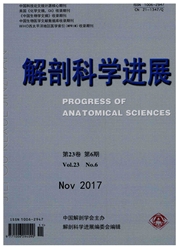

 中文摘要:
中文摘要:
目的研究创伤后应激障碍(PTSD)大鼠大脑前额皮质神经元细胞色素氧化酶(COX)的表达变化。方法采用国际认定的SPS方法刺激大鼠,建立PTSD大鼠模型,于SPS刺激后1d、4d、7d取大脑前额皮质组织,不予刺激作为正常对照,应用COX光电镜酶细胞化学技术,进行大鼠大脑前额皮质神经元COX表达的观察。结果PTSD模型建立后1d、4d、7d光镜下神经元细胞质内COX阳性反应产物颗粒弥散分布逐渐增加,电镜下神经元细胞质内线粒体膜结构上COX反应颗粒分布逐渐减少、线粒体嵴肿胀及膜完整性遭到破坏的程度逐渐增加。结论PTSD的发病机制可能与COX活性表达变化相关,线粒体中的COX释放至胞质中,其酶活性发生了改变,使大脑前额皮质有氧代谢功能降低,进而导致大脑前额皮质神经元的细胞能量代谢障碍。
 英文摘要:
英文摘要:
Objective To study the change of cytochrome oxidase(COX) expression in neurons of the frontal cortex in rats with PTSD(posttraumatic stress disorder).Methods The standard SPS method was applied to establish the rats model with PTSD,the rat frontal cortex was taken at 1d,4d and 7d after exposure to SPS.COX expression of treated groups was detected by enzyme-histochemical microscopy and compared with control group.Results After SPS,cytosolic COX activity gradually increased from 1d to 7d under light microscope.In contrast,on the mitochondrial membrane,COX reactivity reduced or even disappeared within the same period of time.These were followed by the mitochondrial cisternae swelling and the decay of the cytoplasmic membrane integrity in neurons.Conclusion The change of COX activity is correlated to the pathogenesis of PTSD.COX in the mitochondria is released to the cytoplasm and the enzymatic activity is changed.Aerobic metabolism function of mitochondria in the frontal cortex neurons is impaired to cause the cellular energy metabolic disorder.
 同期刊论文项目
同期刊论文项目
 同项目期刊论文
同项目期刊论文
 Single-prolonged stress induces apoptosis in the amygdala in a rat model of post-traumatic stress di
Single-prolonged stress induces apoptosis in the amygdala in a rat model of post-traumatic stress di Activitity of the 5-HT 1A receptor is involved in the alteration of glucocorticoid receptor in hippo
Activitity of the 5-HT 1A receptor is involved in the alteration of glucocorticoid receptor in hippo Increased phosphorylation of extracellular signal-regulated kinase in the medial prefrontal cortex o
Increased phosphorylation of extracellular signal-regulated kinase in the medial prefrontal cortex o Changes of Bax, Bcl- 2 and apoptosis in hippocampus in the rat model of post-traumatic stress disord
Changes of Bax, Bcl- 2 and apoptosis in hippocampus in the rat model of post-traumatic stress disord 期刊信息
期刊信息
